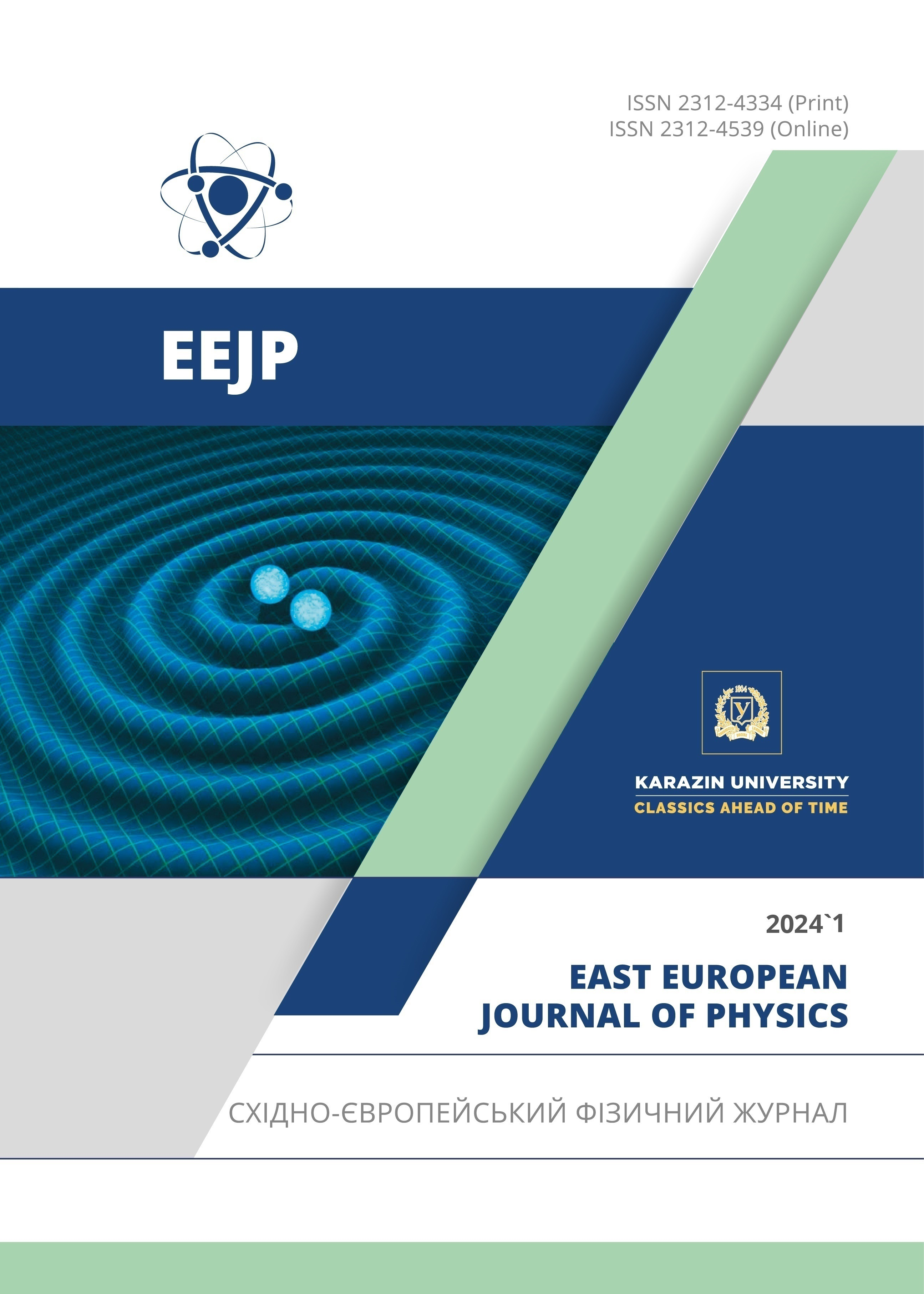В’язка голографічна космологічна модель темної енергії річі типу Б’янкі ІІІ в теорії гравітації Бренса-Діке
Анотація
У цій роботі досліджується та розглядається широкий спектр знахідок, пов’язаних з описом голографічної темної енергії Річчі (HRDE) з об’ємною в’язкістю в рамках прискореного розширення Всесвіту в пізній час у рамках анізотропної космологічної моделі Б’янкі типу III із вмістом матерії без тиску. в теорії гравітації Бренса-Дікке. Ми використовуємо співвідношення між метричними потенціалами, щоб отримати точний висновок рівнянь поля, що призводить до швидкого розширення. Щоб дослідити фізичну поведінку нашої моделі темної енергії, використовуються кілька основних космологічних параметрів, включаючи Хаббла, уповільнення, щільність енергії матерії, щільність темної енергії Річчі (RDE) і рівняння стану (EoS). Використовуючи поточні космологічні спостереження, ми виявили деяку в’язкість голографічної моделі темної енергії Річчі. Ми описуємо, як фізичні та геометричні властивості моделей сумісні з останніми компіляціями.
Завантаження
Посилання
S. Perlmutter, et al., Astrophys. J. 517, 565 (1999). https://doi.org/10.1086/307221
A.G. Riess, et al., Astrophys. J. 659, 98 (2007). https://doi.org/10.1086/510378
R. Amanullah, et al., Astrophys. J. 716, 712 (2010). https://doi.org/10.1088/0004-637X/716/1/712
A.G. Riess, et al., The Astronomical Journal, 116, 1009 (1998). https://doi.org/10.1086/300499
R. von Marttens et al., Physics of the Dark Universe, 28, 100490 (2020). https://doi.org/10.1016/j.dark.2020.100490
S.M. Carroll, et al., Living Rev. Relativ. 4, 1 (2001). https://doi.org/10.12942/lrr-2001-1
T. Padmanabhan, Phys. Rep. 380, 235 (2003). https://doi.org/10.1016/S0370-1573(03)00120-0
T. Padmanabhan, Phys. Rev. D, 66, 02131 (2002). https://doi.org/10.1103/PhysRevD.66.021301
T. Padmanabhan, Gen. Relativ. Gravit. 40, 529 (2008). https://doi.org/10.1007/s10714-007-0555-7
M. Bento, O. Bertolami, and A.A. Sen, Phys. Rev. D, 66, 043507 (2002). https://doi.org/10.1103/PhysRevD.66.043507
R.R. Caldwell, Phys. Lett. B, 545, 23 (2002). https://doi.org/10.1016/S0370-2693(02)02589-3
S. Nojiri, and S.D. Odintsov, Phys. Rev. D, 562, 147 (2003). https://doi.org/10.1016/S0370-2693(03)00594-X
B. Feng, et al., Phys. Lett. B, 607, 35 (2005). https://doi.org/10.1016/j.physletb.2004.12.071
A.Y. Kamenshchik et al., Phys. Lett. B, 511, 265 (2001). https://doi.org/10.1016/S0370-2693(01)00571-8
M.C. Bento et al., Phys. Rev. D, 66, 043507 (2002). https://doi.org/10.1103/PhysRevD.66.043507
V. Sahni, and Y. Shtanov, J. Cosmol, Astropart. Phys. 11, 014 (2003). https://doi.org/10.15407/ujpe57.12.1257
C. Brans, and R.H. Dicke, Phys. Rev. 124, 925 (1961). https://doi.org/10.1103/PhysRev.124.925
S.D.H. Hsu, Phys. Lett. B, 594, 13 (2004). https://doi.org/10.1016/j.physletb.2004.05.020
R.G. Cai, Phys. Lett. B, 657, 228 (2007). https://doi.org/10.1016/j.physletb.2007.09.061
S. Nojiri, and S.D. Odintsov, Phys. Rev. D, 68, 123512 (2003). https://doi.org/10.1103/PhysRevD.68.123512
S. Capozziello, and M. De Laurentis, Physics Reports, 509(4-5), 167 (2011). https://doi.org/10.1016/j.physrep.2011.09.003
T. Harko, et al., Phys. Rev. D, 84, 024020 (2011). https://doi.org/10.1103/PhysRevD.84.024020
G. Hoof’t, https://doi.org/10.48550/arXiv.gr-qc/9310026
A. Cohen, et al., Phys. Rev. Lett. 82, 4971 (1999). https://doi.org/10.1103/PhysRevLett.82.4971
M. Li, Phys. Lett. B, 603, 1 (2004). https://doi.org/10.1016/j.physletb.2004.10.014
C. Gao et al., Phys. Rev. D, 79, 043511 (2009). https://doi.org/10.1103/PhysRevD.79.043511
L.N. Granda, and A. Oliveros, Phys. Lett. B, 669, 275 (2008). https://doi.org/10.1016/j.physletb.2008.10.017
L.N. Granda, and A. Oliveros, Phys. Lett. B, 671, 199 (2009). https://doi.org/10.1016/j.physletb.2008.12.025
S. Chen, and J. Jing, Phys. Lett. B, 679, 144 (2009). https://doi.org/10.1016/j.physletb.2009.07.018
K.V.S. Sireesha, and V.U.M. Rao, Journal of Physics: Conf. Series, 1344, 012028 (2019). https://doi.org/10.1088/1742-6596/1344/1/012028
C.J. Feng, Phys. Lett. B, 670, 231 (2008). https://doi.org/10.1016/j.physletb.2008.11.005
M. Bouhmadi-Lo´pez, and Y. Tavakoli, Phys. Rev. D, 87, 023515 (2013). https://doi.org/10.1103/PhysRevD.87.023515
M. Suwa, et al., J. Mod. Phys., 6, 327 (2015). http://dx.doi.org/10.4236/jmp.2015.63035
S. Ghaffari, et al., Phys. Rev. D, 91, 023007 (2015). https://doi.org/10.1103/PhysRevD.91.023007
C.W. Misner, Nature, 214, 40 (1967). https://doi.org/10.1038/214040a0
C.W. Misner, Astrophys. J., 151, 431 (1968). https://doi.org/10.1086/149448
V.U.M. Rao, et al., Iran. J. Phys. Res. 18, 3 (2018). https://doi.org/10.29252/ijpr.18.3.497
Chakraborty, et al., https://arxiv.org/abs/2006.07142v1
C.L. Bennett, C.L. Astron, et al., The Astrophysical Journal Supplement Series, 148, 97 (2003). https://doi.org/10.1086/377253
O. Akarsu, and C.B. Kilinc, Astrophys. Space Sci. 326, 315 (2010). https://doi.org/10.1007/s10509-009-0254-9
M. Koussour, S.H. Shekh, and M. Bennai, https://doi.org/10.1016/j.dark.2022.101051(2022).
M. Koussour, K.E. Bourakadi, S.H. Shekh, S.K. Pacif, and M. Bennai, https://doi.org/10.1016/j.aop.2022.169092
R.V. Wagoner, Phys. Rev. D, 1, 3209 (1970). https://doi.org/10.1103/PhysRevD.1.3209
V.U.M. Rao, and K.V.S. Sireesha, Eur. Phys. J. Plus, 127, 33 (2012). https://doi.org/10.1140/epjp/i2012-12033-y
V.U.M. Rao, and K.V.S. Sireesha, Int. J. Theor. Phys. 51, 3013 (2012). https://doi.org/10.1007/s10773-012-1183-x
V.U.M. Rao, et al., Prespacetime Journal, 7, 520 (2016).
K.D. Naidu, et al., Eur. Phys. J. Plus, 133, 303 (2018). https://doi.org/10.1140/epjp/i2018-12139-2
N.S. Rani, et al., Journal of Physics : Conf. Series, 1344, 012045 (2019). https://doi.org/10.1088/1742-6596/1344/1/012045
K.V.S. Sireesha, and V.U.M. Rao, The African Review of Physics, 14, 0010 (2019). http://lamp.ictp.it/index.php/aphysrev/article/viewFile/1692/605
V.B. Johri, and K. Desikan, Gen. Relat. Gravit. 26, 1217 (1994). https://doi.org/10.1007/BF02106714
C.B. Collins, et al., Gen. Relativ. Gravit. 12, 805 (1980). https://doi.org/10.1007/BF00763057
J. Ren, and X.H. Meng, Int. J. Mod. Phys. D, 16, 1341 (2007). https://doi.org/10.1142/S0218271807010821
S. Sarkar, Astrophys. Space. Sci. 349, 985 (2014). https://doi.org/10.1007/s10509-013-1684-y
Авторське право (c) 2024 П.Е. Сатьянараяна, К.В.С. Сіріша

Цю роботу ліцензовано за Міжнародня ліцензія Creative Commons Attribution 4.0.
Автори, які публікуються у цьому журналі, погоджуються з наступними умовами:
- Автори залишають за собою право на авторство своєї роботи та передають журналу право першої публікації цієї роботи на умовах ліцензії Creative Commons Attribution License, котра дозволяє іншим особам вільно розповсюджувати опубліковану роботу з обов'язковим посиланням на авторів оригінальної роботи та першу публікацію роботи у цьому журналі.
- Автори мають право укладати самостійні додаткові угоди щодо неексклюзивного розповсюдження роботи у тому вигляді, в якому вона була опублікована цим журналом (наприклад, розміщувати роботу в електронному сховищі установи або публікувати у складі монографії), за умови збереження посилання на першу публікацію роботи у цьому журналі.
- Політика журналу дозволяє і заохочує розміщення авторами в мережі Інтернет (наприклад, у сховищах установ або на особистих веб-сайтах) рукопису роботи, як до подання цього рукопису до редакції, так і під час його редакційного опрацювання, оскільки це сприяє виникненню продуктивної наукової дискусії та позитивно позначається на оперативності та динаміці цитування опублікованої роботи (див. The Effect of Open Access).








